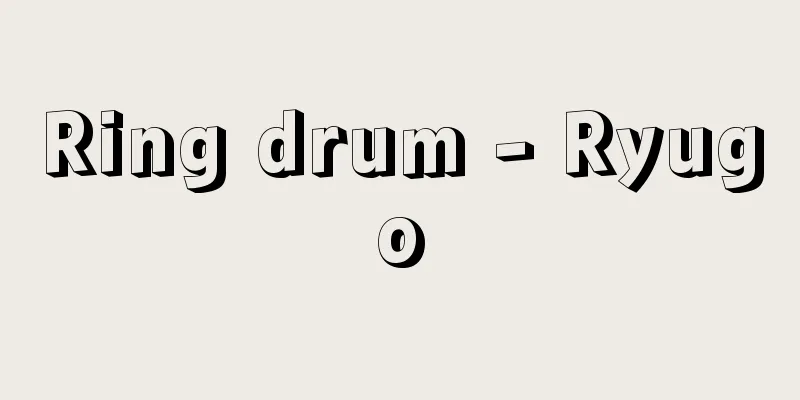Chichibu belt

|
It is one of the division names in the Southwest Japan Outer Zone and the Kanto Mountains in the geotectonic division of Japan. It is distributed in a belt 10 to 20 kilometers wide and 1,500 kilometers long from the Kanto Mountains to the Akaishi Mountains, Kii Peninsula, Shikoku, Kyushu, and Okinawa. It is located south of the Mikabu Green Rocks on the southern edge of the Sanbagawa Belt and refers to the area up to the Butszo Tectonic Line. "Chichibu" comes from Chichibu, Saitama Prefecture. The Chichibu Belt was divided into three belts: the Northern Belt, the Middle Belt, and the Southern Belt. The boundaries between these are basically faults, but their locations vary depending on the researcher. The former Middle Belt of the Chichibu Belt is roughly equivalent to the Kurosegawa Belt, and is sometimes called the Kurosegawa Belt. The Southern Belt of the Chichibu Belt is often called the Sanbo-san Belt. Currently, these are called the Northern Chichibu Belt (Northern Chichibu Belt, Northern Chichibu Belt), Kurosegawa Belt, and Sanbosan Belt (Southern Chichibu Belt, Southern Chichibu Belt, Southern Chichibu Belt), and the term Middle Chichibu Belt has fallen out of use. The strata of the Chichibu Belt were once considered to be geosynclinal deposits, but are now considered to be an accretionary complex. In the northern Chichibu Belt, basaltic volcanic rocks from the Carboniferous to Permian periods of the Paleozoic era, limestone, and chert from the Permian to Mesozoic Jurassic periods are mixed with Jurassic sandstone, mudstone, and alternating layers of sandstone and mudstone, forming a Jurassic accretionary complex. The boundaries with the Mikabu Greenstones are high-angle faults, thrust faults, and normal faults, and there is a section that was formerly known as the Mikabuko Tectonic Line. The Kurosegawa Belt is comprised of ancient granites, high-pressure metamorphic rocks, serpentinites, the Siluro-Devonian system including reef limestone, the ancient and new Ino metamorphic complex, the Permian accretionary complex, Permian clastic rocks, the shallow-marine Upper Triassic and Upper Jurassic systems, and the Cretaceous system which unconformably overlies these. The Cretaceous system also extends into the Northern Chichibu Belt. These strata and rocks of the Kurosegawa Belt are often blocked by high-angle faults. The Sanbosan belt is distributed with Jurassic accretionary complexes. Here, Mesozoic Triassic to Jurassic chert-clastic sequences (a series of deposits from chert, through siliceous mudstone, to sandstone-mudstone interlayers, and back to sandstone) are repeated on thrust faults. These correspond to changes in depositional sites (from ocean floor to ocean trench) caused by plate movement. The southern edge of the Sanbosan belt is distributed with melanges containing blocks of limestone, chert, and basaltic volcanic rocks. The strata of the Chichibu Belt are cut by low-angle thrust faults such as the Butszo Tectonic Line, forming nappes. In the central Kii Peninsula, the strata of the Chichibu Belt are missing due to denudation. [Akihiro Murata] [References] | | | | | | | | | | | | | | | |Source: Shogakukan Encyclopedia Nipponica About Encyclopedia Nipponica Information | Legend |
|
日本の地体構造区分上、西南日本外帯および関東山地における区分名の一つ。関東山地から、赤石山脈、紀伊半島、四国、九州、沖縄にかけて、幅10キロメートルから20キロメートルで、延長1500キロメートルにわたって帯状に分布する。三波川(さんばがわ)帯南縁部の御荷鉾(みかぶ)緑色岩類よりも南側に位置し、仏像構造線までの地帯をさす。「秩父」は埼玉県秩父に由来する。秩父帯は、北帯、中帯、南帯の3帯に分けられていた。これらの境界は基本的に断層であるが、その位置は研究者によって異なる。かつての秩父帯中帯はほぼ黒瀬川帯に相当し、黒瀬川地帯とよばれることもある。また、秩父帯南帯は三宝山(さんぼうさん)帯とよばれることが多い。現在では、秩父帯北帯(秩父北帯、北部秩父帯)、黒瀬川帯、三宝山帯(秩父南帯、秩父帯南帯、南部秩父帯)とよばれ、秩父帯中帯という用語は使われなくなってきた。 秩父帯の地層は、かつては地向斜堆積(たいせき)物とされていたが、現在では付加コンプレックスと考えられている。秩父帯北帯には、古生代石炭紀からペルム紀の玄武岩質火山岩類、石灰岩、ペルム紀から中生代ジュラ紀のチャートなどがジュラ紀の砂岩、泥岩および砂岩泥岩互層と混ざり合い、ジュラ紀付加コンプレックスとなって分布している。御荷鉾緑色岩類との境界は高角断層や衝上(しょうじょう)断層、正断層であり、古くは御荷鉾構造線とよばれている部分がある。 黒瀬川帯には、古期花崗(かこう)岩類、高圧型変成岩類、蛇紋岩類、礁性石灰岩を含むシルル・デボン系、古期・新期伊野変成コンプレックス、ペルム紀付加コンプレックス、ペルム紀砕屑(さいせつ)岩、浅海性上部三畳系・上部ジュラ系、そしてこれらを不整合で覆う白亜系が分布する。白亜系は秩父帯北帯にも張り出して分布している。黒瀬川帯のこれらの地層、岩石は、高角断層によってブロック化していることが多い。 三宝山帯には、ジュラ紀付加コンプレックスが分布している。ここでは、中生代三畳紀からジュラ紀にかけてのチャート‐砕屑岩シーケンス(チャートから珪質(けいしつ)泥岩を経て、砂岩泥岩互層、砂岩に至る一連の堆積物)が、衝上断層で繰り返している。これらは、プレート運動による堆積場の変化(大洋底から海溝)に対応している。三宝山帯の南縁部には、石灰岩、チャートや玄武岩質火山岩類をブロックとして含むメランジュが分布する。 秩父帯の地層は、仏像構造線などの低角衝上断層によって切られ、ナップを形成している。また、紀伊半島中央部では、秩父帯の地層は削剥(さくはく)によって欠如している。 [村田明広] [参照項目] | | | | | | | | | | | | | | | |出典 小学館 日本大百科全書(ニッポニカ)日本大百科全書(ニッポニカ)について 情報 | 凡例 |
<<: Chichibu geosyncline (English spelling)
Recommend
Raw voice - Shirakoe
A term used in Japanese music. Also called "s...
Karakasagayatsuri - Karakasagayatsuri
…Because most of Egypt is desert and trees are sc...
Plastic composite materials
A composite material in which the continuous phase...
Babylon the Great - Babylon the Great
...After that, in the chaos of the 3rd century, t...
Polyxene
…mother of Hector, Paris, and Cassandra. Accordin...
Kṛṣṇamiśra (English spelling) Krsnamisra
...Other types of rūpas include the prahasana (co...
Tsuga diversifolia (English spelling)
… [Toshio Hamatani]. … *Some of the terminology t...
Supraglottic cancer (English spelling)
… [Hirohide Yoshioka]. … *Some of the terminology...
Mirror
...This caused a problem, and the director of the...
Powerful system
A historical concept referring to the state syste...
Lost Generation
A generation of Americans who experienced the deva...
Nisso Conglomerate - Nisso Conglomerate
This large conglomerate was built by Nakano Tomon...
International Trade Secretariats
…Abbreviation for International Trade Secretariat...
De Bello Gallico (The Gallic Wars)
A work by the Roman politician Caesar. A record o...
Kathotia
…[Koezuka Takashi] A huge number of prehistoric r...









